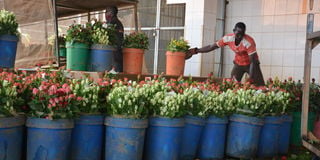Tips for growing flowers for high yield

Rose flowers sorted before packaging for export. PHOTO/Shabibah Nakirigya
What you need to know:
More than 80 per cent of Ugandans are involved in agriculture but there are fears of little interest from young people.
Farmers think that flower growing is one of the most expensive and difficult businesses in Uganda that’s why few have invested in such a business of hortculture. Farmers have revealed how you can earn from this business when you have concentrated on it as your main income earning source.
Despite the outbreak of Covid-19 pandemic across the world, flower growers have registered a high demand of roses from international market and this has given them courage to invest more in this business.
Rajiv Ruparelia the managing director Rosebud Limited in Entebbe says that the demand for cut roses on the international market during the lockdown was very high.
When is the best time to plant?
“Between March and April because demand peaks between September and December,” says Ruparelia.
Apart from the availability of land, capital and seedlings, the farmer says drive and patience are key for success in flower farming. “Some had everything but lack of perseverance saw them give up, they now admire our strong will,” he says.
Planting
To plant the roses, Ruparelia says his gardeners first start by preparing beds in the greenhouses and, thereafter, lays the drip lines. After, they get the stalks from the nursery ready for planting. The stalks are then planted in the beds in a spacing of 30cm from each other and are ready for the first harvest after three months.
Ruparelia reveals they mainly grow the flowers organically to get an edge in the international market.
The farmer says the main challenge is not pests or diseases but keeping the standards set by the world market. To meet the international certification, the roses must pass the billing.
Ruparelia says at the farm, they use dried roses to make manure. His workers shred the stalks and arrange them in a heap and leave them for three months as they turn them until they decompose.
The manure will then be harvested and used mainly when planting new roses. For pest control, they use sticky traps as the international market is sensitive to pesticides. The stickers come in different colours, attracting a wide range of insects such as white flies. “I do not rely on rainfall to grow my flowers because it is very little and inconsistent.”
Harvesting
Rosebud harvests thousands of flower stems in a day, amounting to more than 10,000 boxes each week. After harvesting the flowers, they keep them in a cold room for about an hour to make them remain fresh. Thereafter, they are removed and sorted according to sizes, and later graded.
“We then package the flowers according to colour and sizes and export directly to the market in Europe,” says Ruparelia who encourages anyone interested in flowers to grow them for both local and international market, though he says it is a capital and labour-intensive business. The farm the Ruperalias started in 2000 with just about Shs100m on 13 hectares has expanded its worth to millions of shillings and employs more than 1,500 workers. He confesses that the flower farm gives him tranquillity. “Whenever I come to the flower farm, I just smell the roses and I feel very peaceful.”
Keeping standards
Ruparelia says that standards depend on the quality of roses, how you nurture and look after them to give you the best type of production.
Roses have a specific thickness of the stem, certain size of head and if you have thick stems of roses you are not supposed to export it because it’s already dead weight which is poor quality. “There is also spraying of pesticides on flowers, we are only allowed to use certain types of pesticides and we are guided by the foreign consultants because at the end of the day we buy our goods from foreign countries we only grow for them here and we resell them. We are only the middle part of the chain,” he says.
“As we deal with many big supermarkets chains as our flower outlets these certificates are very much vital and necessary to maintain,” he says.
Challenges
However, even as the business blossoms the road to the top has not been a bed of roses. “Despite bringing billions of shillings to the country, the industry has its own share of challenges including a not so friendly tax approach, costs of maintain standards and high labour charges,” says Ruparelia. He believes a tax holiday will encourage him to double the investment and employ more Ugandans.
Varieties
The rose varieties include Sweetness, Sanoli, Athena, Cape Red, Red Naomi, Panache, Adelaide, Anna-Karina, Airforce, Good times, Ice Bear, Cloud Break, Spritz, Scenta, Mammy Blue, Candid Prophyta and Confidential.




